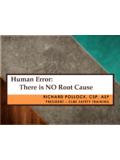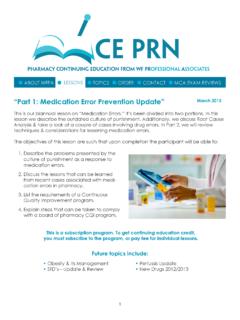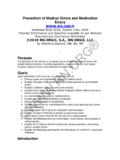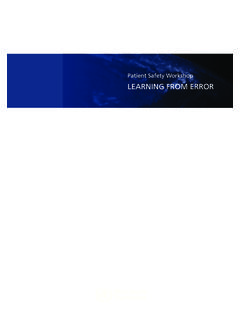Transcription of HSE Human Factors Briefing Note No 3 - Humans …
1 HSE Human Factors Briefing Note No. 3. Humans and Risk Briefing Note 1 Introducing Human Factors ' explains the background to these Briefing notes . A hazard' is anything that can cause harm ( chemicals, electricity, working at height); risk' is the chance that someone could be harmed by the hazard. Any company will be able to manage risks better if it understands where the hazards are and how to control them. Case study From the perspective of the individual facility manager, catastrophic events are so rare that they may appear to be essentially impossible, and the circumstances and causes of an accident at a distant facility in a different industry sector may seem irrelevant. However, while chemical accidents are not routine ..they are a monthly or even weekly occurrence, and there is much to learn from the story behind each accident.. when we look beyond the obvious to the underlying systemic causes of an accident, we see that the same root and contributing causes keep popping up again and again.
2 This indicates that government and industry together are not doing a good enough job at sharing accident information and implementing lessons learned.. The investigation team quoted above reported these interesting findings: before each major accident, there was a series of similar accidents, near-misses and other failures new equipment had been installed before some of the accidents. These two findings suggest that the companies involved did not investigate and learn lessons from earlier events and did not manage the change to the new equipment properly. the following root causes were responsible for many different accidents: hazard review or process hazards analysis were inadequate operators used inappropriate or poorly-designed equipment indications of process condition were inadequate management did not act on early warnings signs of problems. One common and useful method of determining root cause is to keep asking why?
3 This method must be used with a good dose of engineering judgement. The idea is to ask why? enough times to get to the underlying systemic cause of the event, but not so many times that the cause becomes obscured in an overarching general concern which is too vague to address. This sort of over-analysis results in abstractions and doesn't serve any useful purpose.. Source: -1- HSE concerns Companies focus too much of their current risk management effort (performance measures, audits, behaviour modification) on low consequence high frequency events, such as single minor injuries caused by people tripping over. More effort needs to be given to the lower frequency high consequence events such as large releases of hazardous chemicals. These are caused by underlying system failures and triggered, typically, by Human error. Most companies still use very basic methods for accident investigation, rarely looking beyond the immediate causes of the accident and with little supporting procedures or checklists for the investigation.
4 Your MAPP should describe how you identify major accident hazards and assess risks. It should also describe your system for reporting and investigating accidents and near misses (see Briefing Note 12). The case study on the left shows that risk management and incident/accident investigation have a common aim: to find out what could lead to a loss of control over hazards. This Briefing Note provides information on the reasons why you can sometimes lose control over hazards and what you can do to control them more effectively. There is a brief checklist of best practices on page 4. If you don't do a good risk assessment today, you may have to do an accident investigation tomorrow. Learning more about Humans and risk Humans and Risk' is used in this Guidance Note to describe the management system and Human failures that can make people lose control over hazards.
5 To prevent or reduce the chance of such failures, you have to know what the failures are and what causes them. These failures form a chain'. that leads from people in the company who made decisions long before an incident or accident to the person who seems to be immediately responsible. You need to understand this chain and be able to move logically forwards along it to do risk assessments; and backwards to do accident investigations. Slips, lapses, mistakes and violations By directly observing people at work, specialists in Human reliability found that there are four basic types of Human failure. It is important to know that there are different types of failures, because there are slightly different ways of preventing each type. -2- Slip A simple frequently performed physical action goes wrong. You reach for button A'. (which is the raise' control for a hoist) but push button B' (the lower' control).
6 Instead. On the control pad, Button B is below Button A. Your error lowers the object being moved onto electrical cables that carry a critical power supply to the plant. Another type of slip' is reading the wrong instrument. Again, if gauges are too close to each other, there is a risk of reading the wrong one. Example solutions: better layout of controls (and displays); design of controls to make it difficult to operate them accidentally; strict control so you never lift loads above vulnerable equipment (or physical barriers above if you can't avoid this). Lapse A lapse of attention or memory. At Step 9 in your 25-step start-up procedure the phone rings and you answer. Afterwards you go back to the task, forgetting where you were in the sequence. You miss out steps 10 and 11 and go straight to step 12. However, steps 10 and 11 are important safety precautions.
7 Example solutions: provide written procedures that have place markers' or spaces to tick off each step. Supervise key tasks; and strictly enforce rules about interrupting staff on critical tasks. Mistake Not understanding properly how something works or an error of diagnosis or planning. Your plant starts to behave oddly - you notice fluid flowing in a waste pipe through a valve that you believed was closed. You try to work out why it's doing this and how to get the plant back to normal. You don't have exactly the right information or experience. Therefore, your diagnosis, and recovery plan, are wrong. You think the valve has been opened in error so you close it. This diverts fluid via an overflow to a tank. The maintenance crew in the tank had actually opened the valve manually to drain hazardous waste to a treatment vessel while they work. It was their error that they did not tell you, but your solution' sends the hazardous waste into their work area.
8 Example solutions: increase the knowledge and experience applied to such problems (by improving operator competence or by ensuring that operators discuss complex situations in a group and later share knowledge around the plant); use special procedures that guide you to a safe solution. Violation A deliberate breach of rules and procedures; you are fitting a new pump and stores have given you the wrong type of seal. It's almost the same specification as the one you want. It would take too long to get the right one so you fit the one you have and leak test it. It works OK. After a few weeks of operation, the seal fails because it is not designed for that pump. Example solutions: learn from violations; improve culture and attitudes towards safety. -3- Risk management and incident/accident investigation logic You can use this table in two ways. As a guide for incident and accident investigations, it shows the logic of working from what happened down to different underlying causes.
9 As a guide to risk management, you work logically from hazards up to possible outcomes and see what Factors could lead to a hazard happening. In the centre column, the words in brackets are an example case study about moving flammable gas bottles across a worksite. INCIDENT/ACCIDENT INCIDENT OR ACCIDENT RISK MANAGEMENT. INVESTIGATION SEQUENCE (what could happen and (what did happen and how?) how?). Start here and work down Start at the bottom of the the column column and work up Gather facts about the HARMFUL OUTCOME What is the worst case in accident or incident (Personnel injured, plant terms of consequences of the damage by fire) events identified below? What were the immediate EVENT(S) Could the Human failures causes of the harmful (1st operator pushes trolley into identified earlier still lead to outcome? What happened door post; 2nd gas bottles fall release of the hazard?)
10 What just before the damage or off and roll down stairwell; 3rd are the likely consequences injury? some bottles crack and ignite) of those failures? What barriers were reduced BARRIER BETWEEN Are there enough barriers in or removed that allowed the PEOPLE AND HAZARD place to keep the hazard event to take place? (Restraining straps are main under control? Or does the barrier; operator competence risk of releasing this hazard is another) still seem too high? What other barriers are needed? What job, person or PERFORMANCE What could happen to trigger organisational Factors INFLUENCING Factors a Human failure on a contributed to the event? (Operator under time pressure particular day? Environment, What particularly reduced the truck ready to go operator fatigue, overload? barriers against the hazard? immediately) What could we have lost control over? What did the person(s) doing Human FAILURES Could a slip, lapse, mistake or the critical task do (or not do) (Operator does not fasten violation lead to a major that reduced their control over restraining straps; rushes to accident?
















